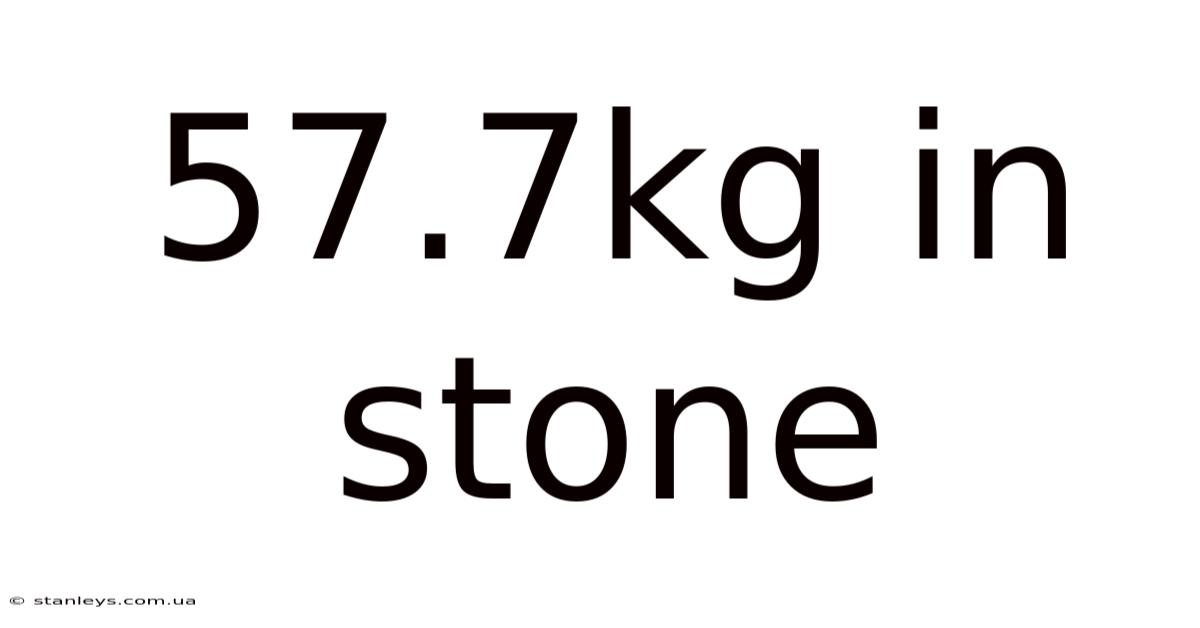57.7kg In Stone
stanleys
Sep 13, 2025 · 4 min read

Table of Contents
Decoding 57.7kg in Stone: A Comprehensive Guide to Weight Conversions and Understanding the Imperial System
Understanding different units of measurement can sometimes feel like navigating a maze. This article delves into the conversion of 57.7 kilograms (kg) into stones (st), a unit still used in some parts of the world, particularly the United Kingdom. We'll not only perform the conversion but also explore the history of the stone, its relationship to other units of weight, and the practical implications of such conversions in various contexts. This guide aims to clarify any confusion surrounding this specific weight conversion and provide a deeper understanding of the imperial system.
Understanding Kilograms and Stones
Before we dive into the conversion, let's briefly understand the units involved.
-
Kilogram (kg): The kilogram is the base unit of mass in the International System of Units (SI), the modern form of the metric system. It's widely used globally and is a decimal-based system, making conversions relatively straightforward.
-
Stone (st): The stone is a unit of mass in the imperial system, predominantly used in the UK and some Commonwealth countries. Historically, its weight varied slightly across regions, but it's now standardized to 14 pounds (lbs). This lack of decimalization makes conversions to and from the metric system slightly more complex.
Converting 57.7kg to Stones: The Calculation
The conversion from kilograms to stones involves a two-step process:
-
Kilograms to Pounds: First, we convert kilograms to pounds. There are approximately 2.20462 pounds in one kilogram. Therefore:
57.7 kg * 2.20462 lbs/kg ≈ 127.17 lbs
-
Pounds to Stones: Next, we convert pounds to stones. Since there are 14 pounds in one stone:
127.17 lbs / 14 lbs/st ≈ 9.08 st
Therefore, 57.7 kg is approximately equal to 9.08 stones.
The History and Significance of the Stone
The stone, as a unit of weight, boasts a rich history deeply intertwined with British commerce and culture. While its exact origins are somewhat obscure, its usage can be traced back centuries. Early forms of the stone varied regionally, reflecting the decentralized nature of early trade and measurement systems. The standardization to 14 pounds occurred relatively recently, contributing to a more consistent and easily understood unit within the imperial system.
The continued use of the stone, despite the global prevalence of the metric system, highlights its enduring presence in specific cultural contexts. It remains a familiar unit for many, particularly in discussions surrounding weight, body mass index (BMI), and even in certain professions like butchering and agriculture.
Practical Applications and Contextual Understanding
The conversion of 57.7kg to stones has practical applications in various scenarios:
-
Healthcare: Doctors and healthcare professionals in the UK might still use stones alongside kilograms when discussing a patient's weight, especially for older patients who are more accustomed to the imperial system. Understanding this dual system is crucial for clear communication and avoiding potential errors in medical records.
-
Clothing and Apparel: Certain clothing manufacturers might still use stone-based sizing systems, especially for larger sizes, though this is gradually becoming less common.
-
Agriculture and Livestock: Farmers and those involved in livestock management might still use stones when referring to the weight of animals, particularly in countries where the imperial system remains prevalent.
-
Sports and Fitness: Some fitness trackers or weightlifting programs may offer the option to display weight in stones, catering to users who prefer this unit.
Addressing Common Misconceptions and FAQs
Many misconceptions surround the stone and its conversion to other units. Here are some frequently asked questions:
Q1: Is the conversion from kilograms to stones always precise?
A1: No, the conversion isn't perfectly precise due to the inherent differences between the metric and imperial systems and the rounding involved in the calculation. The approximation of 2.20462 pounds per kilogram is a commonly used conversion factor, but it's not exact. Minor variations can occur depending on the level of precision required.
Q2: Why are both kilograms and stones still used?
A2: The continued use of both units reflects a gradual transition from the imperial system to the metric system. While the metric system is internationally recognized and preferred for scientific and many commercial applications, the persistence of the imperial system in some regions reflects cultural inertia and habit.
Q3: Are there any other units related to the stone?
A3: Yes, the stone is related to other imperial units like pounds, ounces, and hundredweights. Understanding these relationships helps in performing more complex conversions within the imperial system.
The Importance of Accurate Conversions
Accurate weight conversions are paramount in various professional fields, particularly in healthcare, engineering, and scientific research. Inaccurate conversions can lead to errors with potentially serious consequences. Therefore, using reliable conversion factors and understanding the limitations of approximations is vital.
Conclusion: Beyond the Numbers
This article has explored the conversion of 57.7kg to stones, providing a detailed explanation of the calculation and the context surrounding this seemingly simple conversion. We've delved into the historical background of the stone, its continued relevance, and its applications in various fields. Beyond the numerical calculation, understanding the nuances of different measurement systems and their cultural significance enhances our ability to communicate effectively and navigate a world where both metric and imperial units continue to coexist. The core takeaway is the importance of accuracy and context when dealing with weight conversions, ensuring clear and precise communication across diverse settings.
Latest Posts
Latest Posts
-
30g In Oz
Sep 13, 2025
-
83 3kg To Lbs
Sep 13, 2025
-
48 4
Sep 13, 2025
-
55lb In Kg
Sep 13, 2025
-
50 X 7
Sep 13, 2025
Related Post
Thank you for visiting our website which covers about 57.7kg In Stone . We hope the information provided has been useful to you. Feel free to contact us if you have any questions or need further assistance. See you next time and don't miss to bookmark.